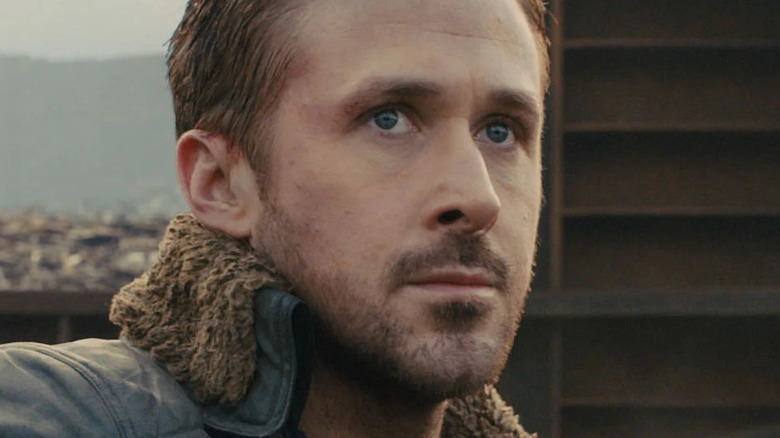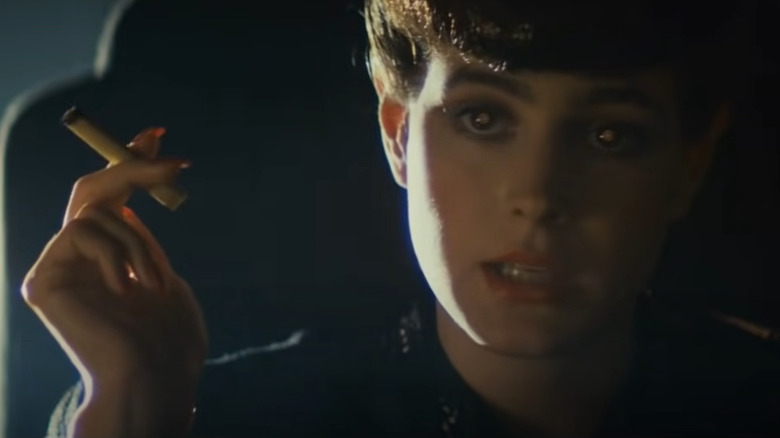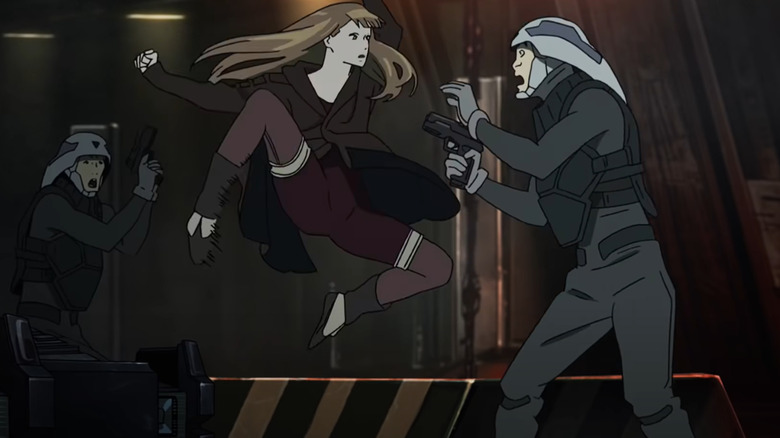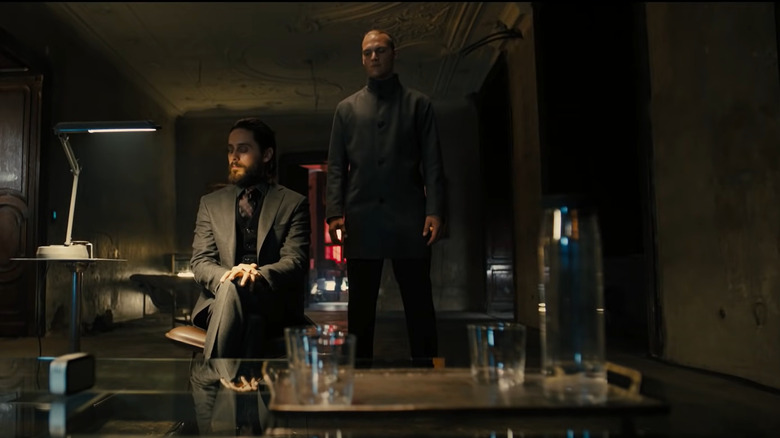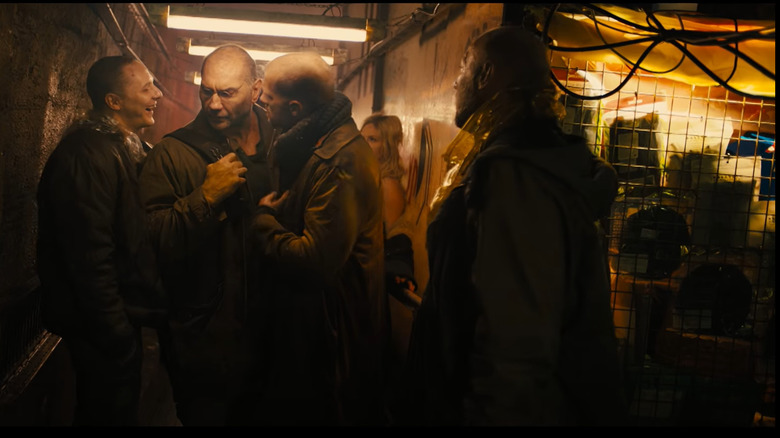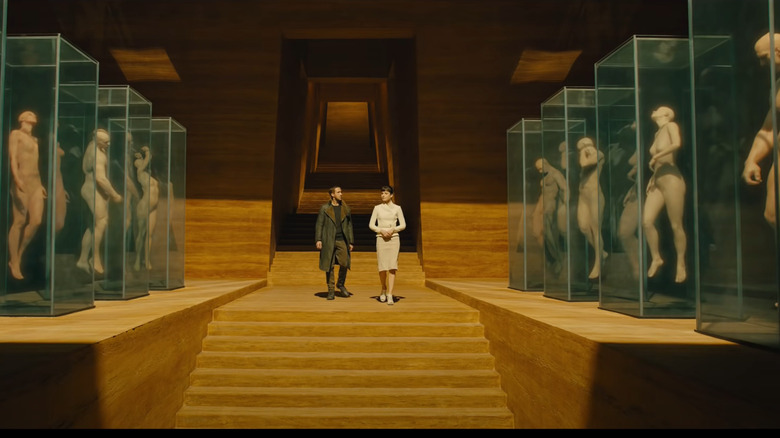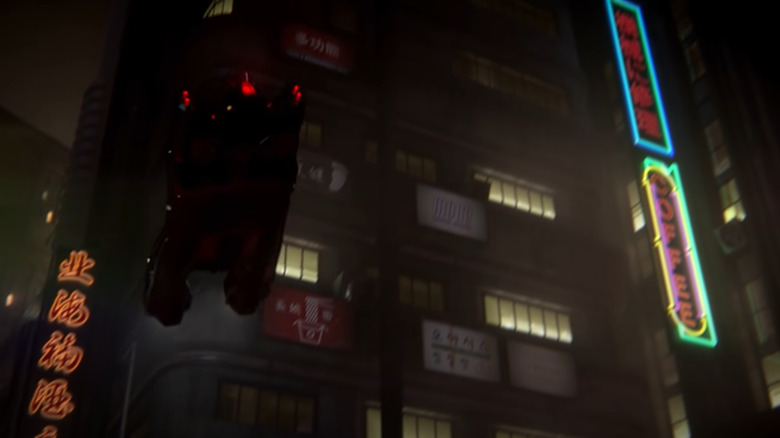Here's The Best Order To Watch The Blade Runner Series
Adapted from the novel "Do Androids Dream of Electric Sheep" by author Philip K. Dick, the "Blade Runner" franchise isn't just characterized by the series' bounty hunters, called "blade runners," who kill artificially intelligent replicants in the near future. It's so distinctive because of its mood, depicting the atmosphere of isolation and the stark beauty of an urban landscape filled with shadow and color.
According to Box Office Mojo, the first "Blade Runner," directed by Ridley Scott, wasn't that successful in theaters when it was released in 1982. This was partly because of a botched release filled with changes from studio executives, including an added noir-style voiceover narration (via Vice). But 40 years later, the film's final cut is considered one of the greatest science-fiction films and a benchmark for the cyberpunk genre.
The critical and cult success of the movie eventually inspired a sequel, released decades later. But there have been other entries in the franchise as well. Here's the best order to watch the "Blade Runner" series.
Watch the original first
Four decades later, the film Ridley Scott doesn't consider sci-fi, "Blade Runner," is still a revelatory vision of the future. Anyone trying to comprehend the franchise's scope should watch it first – with the only question being which version.
When the film first screened, producers insisted that "Blade Runner" be released in a modified cut, with neo-noir narration from star Harrison Ford to clarify the story for audiences, and a new happy ending. The theatrical cut included the voiceover, but Ford hated it, and ironically, so did the executives who had initially requested it (via Vice).
Subsequently, Scott released a 1992 Director's Cut and later the 2007 Final Cut, now considered the "official" version of the film. There the filmmaker returned to the original, ambivalent ending and, of course, got rid of the voiceover. Scott also added a famous "unicorn scene" that created the question of whether blade runner Deckard (Ford) was himself a replicant. Ultimately, the Final Cut is the best version of the film to watch as of 2022, and it's available on HBO Max.
Watch the anime short, Blade Runner Black Out 2022
Viewers may think they should watch the feature film sequel to "Blade Runner" next. But there were actually three short films that take place between the first movie and its sequel. These movies serve as little adventures within the "Blade Runner" universe that also flesh out what happened to humanity and replicants in the years between films.
The first of these to watch is "Blade Runner Black Out 2022," now free to watch on YouTube. Directed by Shinichiro Watanabe, of "Cowboy Bebop" and "Samurai Champloo" fame, the anime short is set three years after the first film's conclusion. The film is centered around the Tyrell Corporation's release of replicants with new similar life spans to humans. This ultimately results in violence against the robots, with humans furious over what some perceive as a looming threat.
The 15-minute film also depicts the end of the Tyrell Corporation, setting up the rise of Wallace's new replicants in the following short.
Check out 2036: Nexus Dawn third
"2036: Nexus Dawn" is directed by Luke Scott, the son of Ridley Scott and a director in his own right (via Deadline). The live-action short film, free on YouTube, is set 13 years after the government's indefinite ban on manufacturing new replicants in 2022 and sets the pace for the "Blade Runner" sequel's story.
Jared Leto stars as Wallace Corporation CEO Niander Wallace, depicting the sinister businessman's attempts to persuade several lawmakers to support his company's push to manufacture a new form of manual labor with his androids. Wallace believes the human race won't survive the dystopian future without this help. Despite the skepticism of these politicians, including Benedict Wong's character, he also reveals that the Nexus-9 is a whole different kind of replicant compared to the Nexus-6 and previous models.
"2036: Nexus Dawn" sets up Wallace's character, the rise of the Wallace Corporation's "product," and also what makes these replicants more compliant compared to the last generation. Niander Wallace will also reappear within the franchise, albeit more than a decade later in the "Blade Runner" timeline.
2048: Nowhere to Run is the final prequel short
The chronological last of the short films within the "Blade Runner" timeline is "2048: Nowhere to Run." The live-action film is also directed by Luke Scott and has the shortest running time of the 3 films. "2048" centers on Sapper Morton (Dave Bautista), a fugitive Nexus-9 replicant hiding in Los Angeles. Despite being on the run, Morton farms leeches and otherwise tries not to attract attention.
Yet Morton is eventually forced to protect a woman (Orion Ben) and her daughter, Ella (Gaia Ottman) from violent thugs, inadvertently giving away his extreme strength in his process. This leads to a bystander spotting him as a runaway "skin-job."
"2048," which is free to watch on YouTube, received positive notice from critics and fans especially for Bautista's performance, with Polygon writing that thanks to the short, "Bautista finally gets his chance to demonstrate what he's capable of." ReddJudicata similarly wrote, "That was real acting. I'm impressed." The actor would reprise his role as the replicant in the next feature film in the series.
Blade Runner 2049 continues Deckard's story
Originally Ridley Scott had planned to direct the official "Blade Runner" sequel, but he eventually chose to finish his sequel "Alien: Covenant" (via The New York Times). Instead, the new film was helmed by Denis Villaneuve after he'd directed "Enemy" and the critically acclaimed "Arrival," and his full-fledged sequel has plenty of scenes that deserve a second watch.
"Blade Runner 2049" reveals that in the aftermath of the first film, blade runners are mainly replicants who are controlled by their police departments. K (Ryan Gosling) is one such blade runner, assigned early on with confronting fugitive Sapper Morton (Dave Bautista). In the process, however, K discovers a secret about replicants which sends him on a search for Deckard (Harrison Ford), long after he retired and disappeared from sight.
The ambitious science fiction film was critically acclaimed, with Indiewire calling it "a lush, often mind-blowing refurbishing of the original sci-fi aesthetic." However, like the original, it was a box office disappointment (via Deadline). Still, this didn't derail Villaneuve's career, per Den of Geek, nor did it stop the next installment in the series.
Blade Runner: Black Lotus fills in the gaps
The most recent screen adaptation of "Blade Runner" is the 2021 CGI series "Blade Runner: Black Lotus." The show was co-produced by Crunchyroll and Adult Swim and premiered with them (via IGN). You can currently stream it on Crunchyroll with a subscription.
"Blade Runner: Black Lotus" is set in Los Angeles in 2032, 10 years after "Black Out 2022," but before Niander Wallace manufactured the Nexus-9 models. "Black Lotus" fits into the greater universe by exploring the aftermath of the blackout and is best seen last because of how it fills gaps in the timeline.
Elle (Jessica Henwick) is a female replicant on the run who wakes up with few memories. The fugitive must discover who she is and why a powerful senator and a mysterious industrialist are seeking her.
Upon release, the show's 13 episodes were met with fairly positive reviews (via Rotten Tomatoes). However, according to Collider, the recent merger of Warner Bros and Discovery ultimately resulted in several Adult Swim anime series getting canceled, including "Blade Runner: Black Lotus."
While that's bad news for fans and new viewers, the "Blade Runner" franchise will continue via the upcoming "Blade Runner: 2099" series by Ridley Scott.
